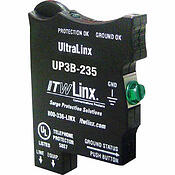Recently, a leading manufacturer of surge protectors recalled 15 million of their products due to malfunctions including overheating, melting and causing fires. The U.S. Consumer Product Safety Commission received at least 700 reports of these products overheating and melting, including 55 reports of property damage from smoke and fire, and 13 reports of physical injuries including smoke inhalation and burns. These problems do not only occur with defective products, however- these circumstances also arise when even well-designed products are used beyond their capacities. The damage can be extreme, but the problem is avoidable.
ITW LINX was featured in last month's Security Sales & Integration magazine. The magazine included ITW's most recent article entitled, "Be Certain When It Comes to Surge Protection" authored by Jeff Oliveros. See below for an excerpt from the article.
 To see the full article, click here.
To see the full article, click here.
Be Certain When It Comes to Surge Protection
By Jeff Oliveros
Excerpt:
Power strip vs. surge protector — Though they look very similar, a power strip is very different from a surge protector. While both can offer additional plug outlets for use, only the latter provides protection in case of an electrical surge. It is very common for people to mistake these two technologies. Verify your clients have UL-Listed surge protectors rather than simple power strips in order to ensure maximum safety and protection.
Overloading — It is a common misconception that it is safe to plug as many items as will fit into a given surge protector. One might logically, yet mistakenly, assume if a surge protector has six outlets, six different electric/electronic items can be plugged into that surge protector. This is not always the case. Different items have different power consumption levels. Remind your clients to carefully study the power limitations on their surge protectors and the items plugged into them. As standard practice, when installing security systems ensure technologies do not exceed 80% capacity load on any given surge protector.
Age of surge protector — Many surge protectors in use are legacy products that were designed eight to 10 years ago, some at very low cost. These devices often do not have effective thermal protectors and were not built with the latest flame-retardant materials. Many of these legacy surge protectors have also experienced small surges through the years, degrading and compromising components over time and making them more susceptible to failure. While it is not easy for users to discover what types of thermal protectors and materials are used in their surge protectors, a good rule of thumb is to check the technology’s age. If your client’s surge protectors are more than eight years old, encourage them to replace the devices with newer technologies.
To read the full article, click here, or to learn more about ITW Linx and surge protection, contact us today.


.png?width=58&height=58&name=X_logo_2023_(white).png)
